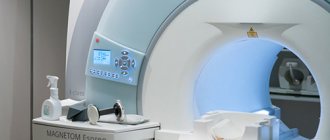21.05.2013
Maltseva Marina Arnoldovna
Head of the consultation department - neurologist, specialist in the field of extrapyramidal pathologies, doctor of the highest category
The human brain is the crown of development of human nature, allowing us to develop and transform our own lives in accordance with our goals. We owe most of the body functions responsible for our life to the work of the central nervous system. The human brain is an incredibly complex organ that leads to the coordinated functioning of almost all systems in the body. not to mention the higher nervous activity responsible for cognitive skills and thought processes. Unfortunately, a fast pace and far from the healthiest lifestyle slowly undermine the body, depleting its reserves and compensatory mechanisms. Today, the world faces an acute problem associated not only with high morbidity, but also with disability and even mortality from cardiovascular diseases. Among such diseases, organic brain damage of an ischemic and hemorrhagic nature is in the first place. It is important to note that despite the significant preponderance in the morbidity structure of people in the older age group, namely 45 years and older, organic brain damage can also occur in children.
A brief excursion into the anatomy of the central nervous system
The human brain is a complex organ responsible for the functioning of the entire organism. There is a clear hierarchy in the structure of the brain, which allows the entire body to work effectively. The central nervous system can be divided into several main parts:
- The cerebral cortex is responsible for higher nervous activity, i.e. thought processes, speech, memory, writing, hearing and many other functions.
- Subcortical structures that form the midbrain. The midbrain is responsible for the primary reflex units and the formation of unconditioned reflexes.
- The bridge is a connecting link between all parts of the central nervous system and the cerebral cortex.
- Cerebellum. It is located in the lower occipital part of the head and is responsible for human coordination in space.
- The medulla oblongata connects the brain with the spinal cord and is its continuation. The medulla oblongata contains vital centers: vasomotor and respiratory.
Treatment of organic pathology and mental disorders
First of all, the cause of organic pathology should be established. Treatment tactics will depend on this.
In case of infectious pathology, antibiotics sensitive to the pathogen should be prescribed. For viral infections - antiviral drugs and immunostimulants. For hemorrhagic strokes, surgical removal of the hematoma is indicated, and for ischemic strokes, decongestant, vascular, nootropic, and anticoagulant therapy is indicated. For Parkinson's disease, specific therapy is prescribed - levodopa-containing drugs, amantadine, etc.
Correction of mental disorders can be medicinal and non-medicinal. The best effect is shown by a combination of both methods. Drug therapy includes the prescription of nootropic (piracetam) and cerebroprotective (citicoline) drugs, as well as tranquilizers (lorazepam, tofisopam) and antidepressants (amitriptyline, fluoxetine). To correct sleep disturbances, hypnotics (bromizoval, phenobarbital) are used.
Psychotherapy plays an important role in treatment. Hypnosis, auto-training, Gestalt therapy, psychoanalysis, and art therapy have proven themselves well. This is especially important when treating children due to possible side effects of drug therapy.
What is brain damage?
Organic brain damage is primarily a symptom of a disease, manifested by disruption or loss of a number of functions as a result of the pathogenic effect of some factor on brain tissue. The etiology of brain damage can be very diverse, and this will be discussed in more detail later in the article. Organic damage means that brain cells - neurons - are exposed to a variety of influences, which lead to the formation of dystrophic processes inside neurons and disrupt their functional activity. In the most serious cases, neurons simply undergo first necrobiosis and then necrosis, i.e. are dying. The death of a large number of neurons localized in a single anatomical space leads to the loss of one or another function in the body of the affected person, and the identification of a disturbed function allows specialists to understand in which part of the brain the catastrophe occurred - this is called topical diagnostics. Symptoms of organic brain damage in children manifest themselves differently than in adults, since the full activity of the higher nervous system has not yet been formed. Children may experience delays in mental, mental and physical development, unstable mood and behavioral abnormalities.
Pathogenetic mechanisms of neuronal damage
A number of mechanisms of different nature can lead to organic damage to the brain. This pathological condition can be provoked by both external and internal factors, and this must be taken into account, since therapeutic measures, depending on the pathogenetic type of development of damage to brain neurons, will differ radically.
Violation of energy supply
The most common pathogenetic variant of brain damage is associated with an imbalance between the need of neurons for energy and its entry into the cell. Energy deficiency can develop due to insufficiency:
- Nutrients in the victim's body, for example as a result of hypoglycemia, when there is not enough glucose in the blood;
- Oxygen, which causes a condition such as hypoxia. Brain hypoxia causes damage to nervous tissue and often occurs in acute ischemic or hemorrhagic cerebrovascular accidents. In children, brain hypoxia can develop in the antenotal period and during childbirth, which leads to anoxic brain damage in the child.
- When the concentration of potassium, calcium, sodium and chlorine ions increases or, conversely, excessively decreases, transmembrane proteins may malfunction, which also entails energy deficiency inside the cell.
It is worth noting that energy deficiency leads to rapidly progressive damage to brain tissue and within 5-7 minutes, in the absence of sufficient oxygenation, neurons begin to experience acute hypoxia and die. Damage to the blood vessels of the brain has the following symptoms:
- The patient notes memory impairment;
- There is a decrease in vision and hearing;
- The synthetic activity of the brain slows down;
- When performing angiography of cerebral vessels, multiple stenoses of cerebral vessels can be detected;
- MRI of the brain shows dystrophic disorders and a decrease in the volume of the cerebral cortex.
All of the above symptoms are signs of systemic atherosclerosis, which affects most older people. Atherosclerosis leads to the formation of discirculatory encephalopathy.
Traumatic injuries
Injuries are always associated with mechanical damage to the brain and the subsequent development of edema, which leads to an increase in intracranial pressure. Since the brain is located in the cranium and literally floats in the cerebrospinal fluid - intracerebral fluid, the consequences of blows and bruises become serious. Despite. The cerebrospinal fluid plays a protective and shock-absorbing role; with the development of a brain contusion, an increase in intracranial pressure occurs, since the fluid is not physically compressible. Brain cells are exposed to excessive pressure and begin to die. Brain tissues occupy up to 96% of the volume of the cranial cavity, which makes this organ very sensitive to changes in intracranial pressure.
It is very important to note that quite often injuries are accompanied by internal hemorrhage, which can lead to the formation of an extensive hematoma and displacement of the brain. Dislocation of the brain leads to wedging of its subcortical structures into the foramen magnum, which inevitably leads to the death of neurons located in the nuclei of the vasomotor and respiratory centers, without which the life of the victim is impossible.
Infectious
Brain damage can be caused not only by physical factors. But also biological. Conditions such as meningitis, encephalitis, and ventriculitis can significantly impair the functional activity of the brain.
- Meningitis is an inflammation of the lining of the brain. Etiological factors can be very diverse, so the brain can be affected by many bacterial and viral diseases. Inflammation of the membranes of the brain can occur primarily through direct infection through the wound gate. And secondarily – as a result of an immunodeficiency state.
- Encephalitis is inflammation of the brain tissue itself. Encephalitis is an even more severe infectious disease than meningitis. As a result of encephalitis, purulent melting and liquefaction of areas of the brain can occur, which leads to the formation of persistent disturbances in the functioning of various organs of the victim. With encephalitis, brain damage very often leads to disability or even death.
- Ventriculitis is an inflammation of the integumentary tissues lining the ventricles of the brain. This disease occurs in newborns and infants and leads to increased intracranial pressure and the development of hydrocephalus due to insufficient drainage function of the cerebrospinal fluid.
The brain can be affected by both specific and nonspecific infectious agents; this is important to consider when prescribing treatment, since antibacterial therapy regimens will vary.
Congenital pathology
Anomalies of brain development can form in the very early stages of a child’s development. The first trimester of pregnancy is the most dangerous for the woman and the fetus, since the pregnant woman’s body and the fetus are unprotected from external factors, and at the time of the initiation and formation of organs, the most dangerous anomalies and gross developmental pathologies can form, for example micro or acephaly.
Toxic damage
Not the most common type of brain damage, but nevertheless it does occur. Brain damage occurs if the chemical has neurotoxic properties and is able to cross the blood-brain barrier. Neurotoxic agents lead to organic damage in various parts of the nerve cell; most often, neurons suffer from disruption of the transmembrane transfer of nutrients and disturbances in the synthesis of neurotransmitters. Toxic injuries of varying severity can lead to both persistent encephalopathy and complete loss of some functions of the person affected by intoxication. Most often, gross organic damage to the brain is caused by substances such as arsenic and nitrogen metabolism products, with excessive accumulation of the latter in the blood plasma.
Oncological diseases
Brain damage in oncology can be primary. When a tumor develops directly from brain tissue or secondary - when atypical tumor cells are metastatically introduced into the brain.
Common Causes
At the initial stages of diseases, it is very difficult to detect them, since most of them occur without visible symptoms, or are manifested by minor pain.
The following internal and external causes can lead to the disease:
- severe infections that entered through wounds, insect bites, respiratory tract or blood/lymph from other infected areas of the body;
- trauma to the skull;
- chemical poisoning;
- excessive exposure to radiation;
- adherence to bad habits, systematic intoxication with alcohol, tobacco, drugs or certain medications;
- poor quality of food;
- genetic predisposition to brain destruction;
- congenital disorders.
Types of brain lesions
Brain damage can be either focal or disseminated. Let's figure out what focal brain damage is. This is a condition in which there is a clearly demarcated single focus with necrotic tissue, i.e. This is a local brain lesion. This type of damage often occurs during acute cerebrovascular accident.
Disseminated or multifocal brain damage is a type of injury in which multiple scattered foci of damage to brain tissue are detected. The multifocal form occurs in infectious diseases of the brain, for example, when an infectious agent is introduced hematogenously into the medulla or with an oncological lesion.
When is it time to go to the doctor?
Only a medical specialist can understand what is happening. If discomfort in the head, neck or upper back appears sporadically, for example, when the weather changes, and then disappears without a trace for a long time, there is usually no cause for concern. If you suspect a cold, headache from fatigue, physical or mental stress, just rest. But if you experience the following symptoms, you should definitely go to the doctor:
- previous head injuries with and without complications;
- feverish condition;
- blurred perception;
- muscle tension in the neck or back of the head;
- sudden painful shootings;
- loss of sensation in the arms or legs;
- convulsions;
- problems concentrating your eyes or thoughts;
- bulging of the fontanelle in the newborn period.
Even short-term loss of vision or hearing is also a serious reason for medical intervention.
Treatment tactics
Treatment of organic brain damage can be very diverse and depends on the pathogenetic mechanism of development of the damage and the immediate cause.
Treatment of organic brain damage can be surgical and conservative. For example, the development of high intracranial pressure, which poses a threat to life, can be treated both surgically and conservatively. Surgical treatment - the application of a burr hole for brain decompression is applicable in the formation of a severe hematoma due to trauma or hemorrhagic stroke, and conservative therapy is possible with a moderate increase in intracranial pressure without brain dislocation. For conservative therapy, diuretics are used that cause forced diuresis, allowing for the rapid elimination of edema.
Treatment of cerebral artery atherosclerosis can also be either surgical or conservative. Surgical – angiography with the installation of stents to widen the lumen of the arteries. Conservative – antithrombotic therapy and correction of dyslepidemia.
Clinical Brain Institute Rating: 4/5 — 16 votes
Share article on social networks
How to correctly identify the disease?
As soon as a preliminary history is collected, complaints are heard, first assumptions about a possible disease are made, a comprehensive diagnosis is prescribed, which includes the following procedures:
- Laboratory blood analysis.
- Radiography.
- Electroencephalography.
- Angiography.
- MRI of the brain.
- CT scan of the skull or cervical spine.
- MRI of soft tissues of the neck.
The most informative techniques are tomographic sessions. They give a complete picture of the existing changes in tissues and the root cause of the pathology. Even microscopic abnormalities, precancerous stages, and vascular abnormalities clearly appear on scans in one short procedure.
To undergo a full examination at a specialized tomography center, just contact our service, which works free of charge. Choose CT or MRI services, consider offers from different clinics in the city, compare options based on prices, equipment, ratings and other criteria. Here you can remotely consult on existing questions and sign up at your favorite institution with discounts from the service. Contact us, we will be happy to help you.
Programs:
Assessment of rehabilitation potential
Movement restoration
Restoration of cognitive functions
Early (resuscitation) rehabilitation
Rehabilitation after strokes and injuries
Atherosclerosis
It is a neoplasm (plaques) in the vessels of the brain that block the flow of blood into it and, accordingly, cause oxygen starvation of neurons.
At first, it is very difficult to identify the disease, so they consult a doctor at a later date. By this time, blood clots have already formed in the vessels, some areas of the brain have undergone necrosis, cysts have appeared, and the activity of the entire organ has been disrupted.
The causes of the development of atherosclerosis are:
- high cholesterol in the blood;
- hypertension;
- the presence of chronic diseases (thyroid problems, diabetes, etc.).
Most often, such brain problems occur in old age. You can understand the development of this disease by the following signs:
- Frequent and painful headaches.
- Feeling of anxiety, fear.
- Constant ringing in the ears.
- Nervousness.
- Organic damage, that is, decreased attention, a feeling of depression, apathy.
- Insomnia.
- Frequent fainting.
- Decreased performance.
To treat atherosclerosis, drugs are prescribed that:
- Limit the intake of cholesterol into the body.
- Strengthens the body's ability to remove cholesterol.
- Reduce the symptoms of the disease.
- Normalizes fat metabolism in the body.
- Improves the condition of the walls of blood vessels.
- Normalizes blood flow in the body.
It is also very important to take preventive measures to prevent brain disease from returning. These include: proper and balanced nutrition, giving up bad habits and exercising.
Migraine
It is characterized by frequent attacks of headaches that occur due to spasms of cerebral vessels. Conventional painkillers will not help here; properly selected therapy is needed.
Often, a migraine occurs on one side of the head and is accompanied by attacks of nausea and even vomiting. To cure this disease, it is necessary to undergo a series of examinations, and only after that the doctor will prescribe treatment. Sometimes a whole list of medications is required to eliminate a severe attack of pain.
Hydrocephalus
This disease is characterized by excessive accumulation of cerebrospinal fluid in the brain. Hydrocephalus is manifested by increased intracranial pressure, headache, a feeling of constriction in the eyes, hypertension, mental disorders, seizures, etc. The reason for the development of the disease lies in the disruption of the brain's cerebrospinal fluid system. This pathology can manifest itself at any age, but children, especially premature infants, are most often susceptible to it.
Among the causes of the disease can also be identified: intrauterine infections, birth injuries, encephalitis, traumatic brain injuries, vascular disorders, etc.
The disease can be identified by the following signs:
- Headache.
- Nausea and vomiting.
- Feeling of tightness in the eyes.
- Dizziness.
- Noise in ears.
- Decreased vision.
Amyotrophic lateral sclerosis
This disease more often affects men and leads to damage to motor neurons, gradual disruption of muscle function, and their atrophy. To date, it has not been revealed why people begin to suffer from amyotrophic lateral sclerosis. Genetic mutations account for only 5-10% of cases of the disease.
The first symptoms are problems with muscle control in the arms, then in the legs. As the disease progresses, patients have less and less control over their muscles. The disease is incurable and death occurs as a result of weakening of the respiratory muscles.
Meningitis
The most common cause of meningitis is meningococcal infections. Most often it affects children under 5 years of age. The second risk group is teenagers and young adults.
The symptoms of meningitis vary. Usually the disease begins with a sudden fever, sometimes vomiting is present. After 4-6 hours there is a temporary improvement, but then the clinical condition worsens. Depending on the form of meningitis, symptoms appear: headache, convulsions, high fever, impaired consciousness or symptoms of sepsis, which is characterized by a hemorrhagic rash that most often affects the legs.
Intracranial hypertension
This anomaly indicates the development of a serious brain pathology (cyst, tumor, etc.). The most common symptoms of brain tumors, including cancer, are:
- attacks of headache;
- bluish complexion;
- lumen of the vascular network on the body;
- attacks of nausea and vomiting;
- increased blood pressure;
- sensitivity to weather conditions.
Before starting treatment, it is necessary to identify the causes of the disease, according to which therapy is prescribed, including a specially selected diet, medication and special exercises. If the case is advanced, surgical intervention is recommended.








